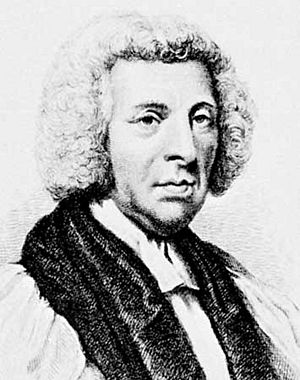Thomas Percy (bishop of Dromore) facts for kids
Thomas Percy (born April 13, 1729 – died September 30, 1811) was an important figure in English literature. He became a Bishop of Dromore in Ireland. Before that, he served as a chaplain to King George III. Percy is best known for his book, Reliques of Ancient English Poetry, published in 1765. This book was one of the first big collections of old songs and poems called ballads. It helped bring these old stories and poems back into style, which was a big part of the Romantic movement in poetry.
Contents
Who Was Thomas Percy?
Thomas Percy was born in Bridgnorth, Shropshire, England. His father, Arthur Lowe Percy, was a grocer and farmer. Thomas went to school at Bridgnorth Grammar School and then Adams' Grammar School in Newport.
After school, he studied at Christ Church, Oxford starting in 1746. He finished his first degree in 1750 and earned his master's degree in 1753. That same year, he became a vicar (a type of church leader) in Easton Maudit, Northamptonshire. A few years later, in 1756, he also became a rector (another church leader role) in Wilby. He kept both jobs until 1782. In 1759, he married Anne Gutterridge.
Percy's Writings and Collections
Thomas Percy wrote and translated many books. His first major work, Hau Kiou Choaan, or The Pleasing History, came out in 1761. This was a revised translation of an old Chinese novel, and it was the first time a full Chinese novel was published in English. The next year, he published more translations about Chinese culture.
In 1763, he published Five Pieces of Runic Poetry, which he translated from the Icelandic language. He also worked on poems by the Earl of Surrey and translated parts of the Song of Solomon from the Bible.
His book Northern Antiquities (1770) was a translation of a French work. He also edited a book about the daily life of the Earl of Northumberland's household in 1770. This book is very helpful for understanding how people lived in England a long time ago.
The Reliques Collection
Percy's most famous work is Reliques of Ancient English Poetry (1765). In the 1760s, he found an old book of ballads, known as the Percy Folio, in Northumberland. He was actually looking for old stories about the Percy family (who were important nobles, the Dukes of Northumberland). He found many old ballad tales near Alnwick, which was the family's historic home.
In 1763, Percy published Five Pieces of Runic Poetry. He wanted to appeal to readers who liked "ancient poetry," a style that was popular at the time.
Percy was friends with other famous writers like Samuel Johnson, Joseph and Thomas Warton, and James Boswell. In 1764, his friends encouraged him to collect and save the old poems he was finding. So, Percy started looking for more ballads, especially from areas near the border with Scotland. In 1765, he published the Reliques, and it was a huge success!
Life as a Bishop
In 1769, Thomas Percy became a chaplain to King George III. He also received a special degree from Cambridge University in 1770.
Even after becoming famous, Percy continued to write. He wrote his own ballad poem called The Hermit of Warkworth in 1771. This poem was about Warkworth Castle, which was a ruin at the time. His friend Samuel Johnson even made some funny parodies of Percy's poem, but it was all in good fun.
Percy did most of his important writing work in Easton Maudit. Because he was so famous, he became a special chaplain to the Duke and Duchess of Northumberland. This led him to believe he was connected to the important Percy family. With the Duke's help, he became Dean of Carlisle Cathedral in 1778. Finally, in 1782, he was made Bishop of Dromore in County Down, Ireland.
His wife, Anne, passed away in 1806. Bishop Percy lived for five more years, even though he was blind. He and his wife were buried in the transept (a part of the church) that Percy had added to Dromore Cathedral.
Percy's Literary Impact
The Reliques of Ancient English Poetry was very important for future writers. It inspired poets like Robert Burns, and also Wordsworth and Coleridge's famous book, Lyrical Ballads.
The Reliques book was based on an old handwritten collection of poems. Percy said he saved this manuscript from a housemaid who was about to use it to light a fire! This old manuscript formed the main part of his book. However, he also found many other ballads, some from his friends like Johnson and William Shenstone, and some from a collection made by Samuel Pepys.
Percy "improved" many of the ballads from the old manuscript. For example, in the ballad "The Beggar's Daughter of Bednal Green" (Bethnal Green), he added the historical character of Simon de Montfort. This version of the ballad became so popular that it was used in plays, a novel, and even operas.
Percy's Collections Today
After Thomas Percy died, his daughters kept his collection of about 120 books. In 1933, his great-granddaughter, Miss Constance Meade, gave these books to the Bodleian Libraries at Oxford University.
These books were mostly literary works from the 17th to 19th centuries. They included copies of books by authors like Goldsmith and Johnson, with Percy's own notes written inside them.
Other printed items, like old papers and pamphlets that had been passed down in the Meade family, were given to the John Johnson collection at the University Press in 1930. This collection is now also part of the Bodleian Library.



